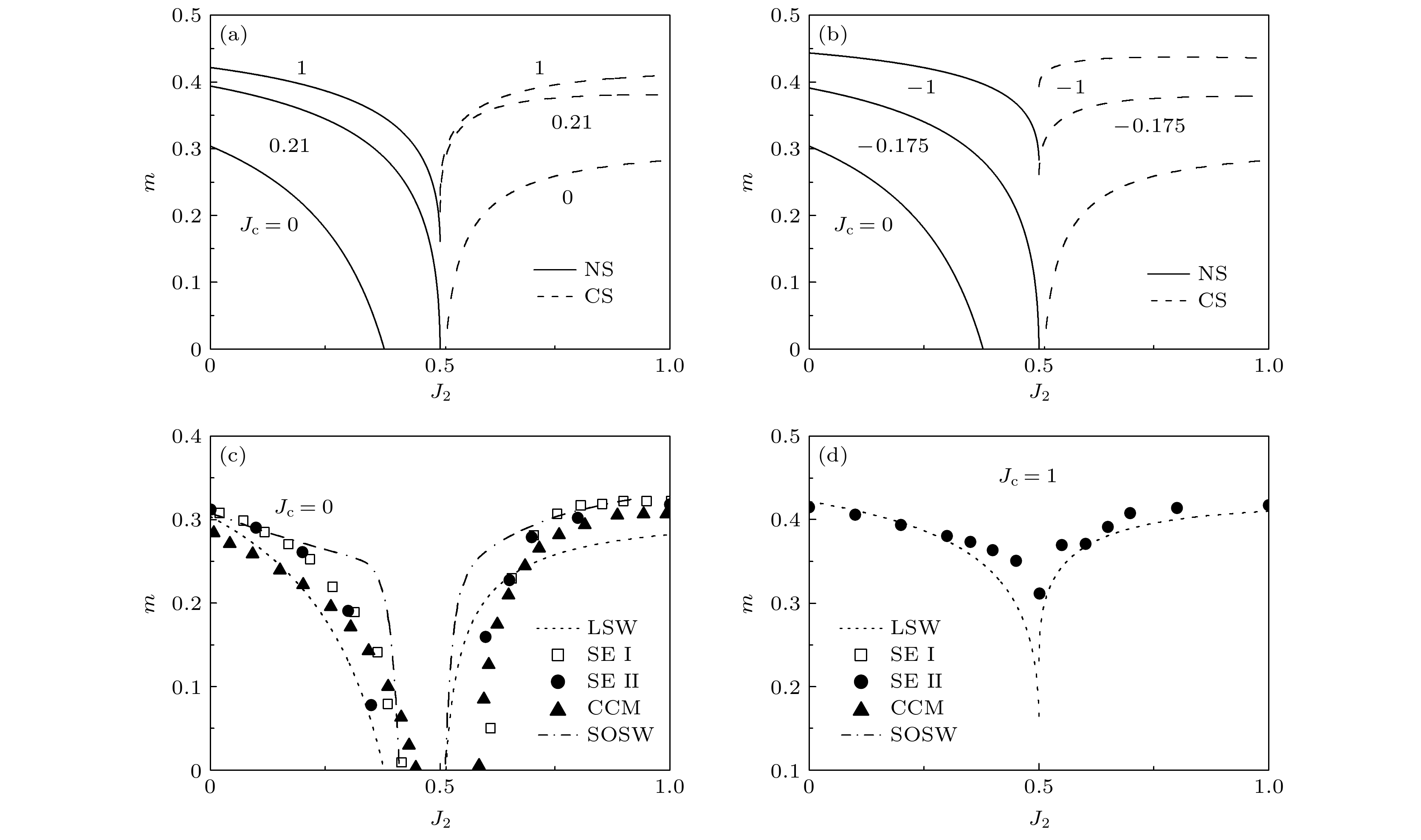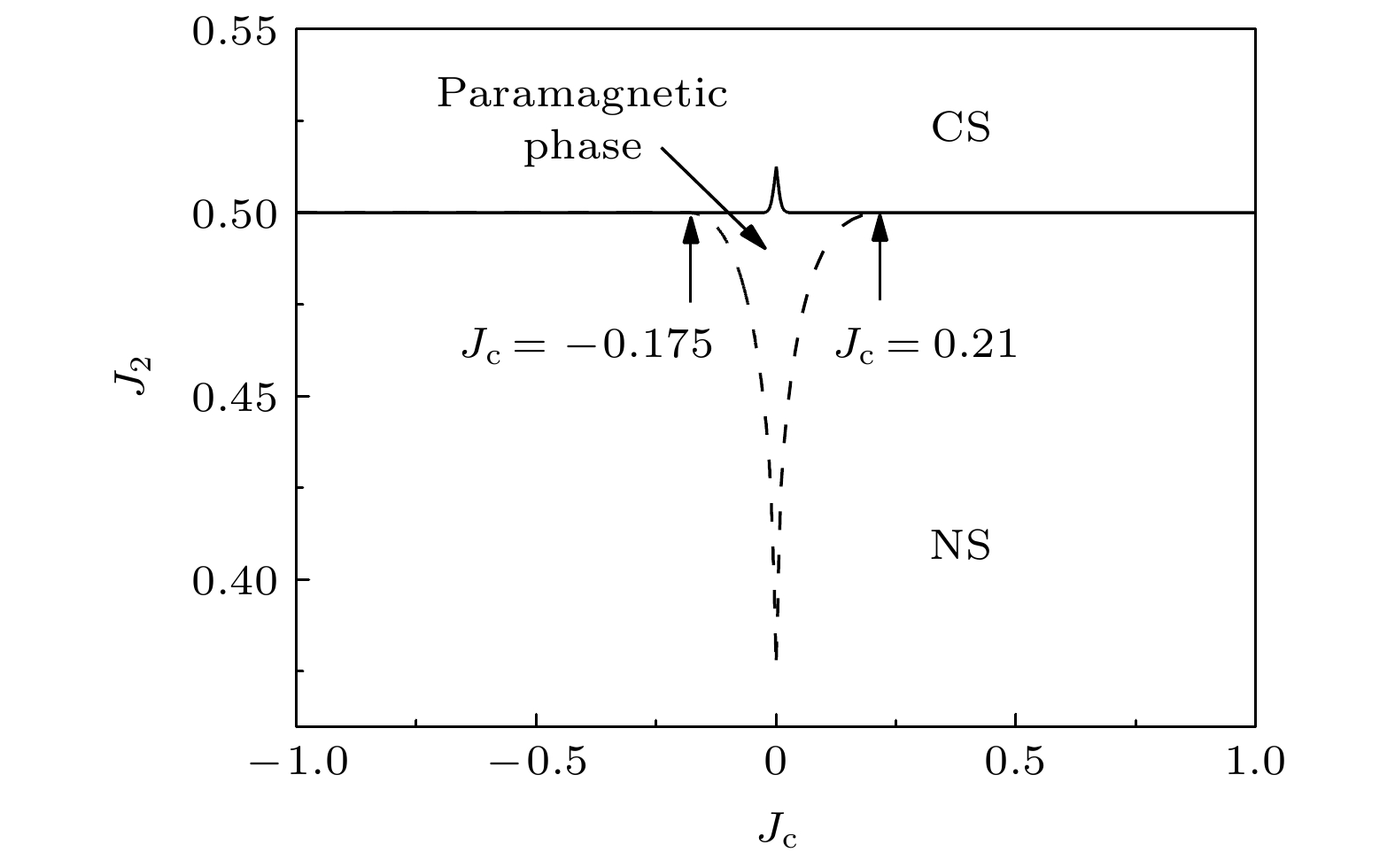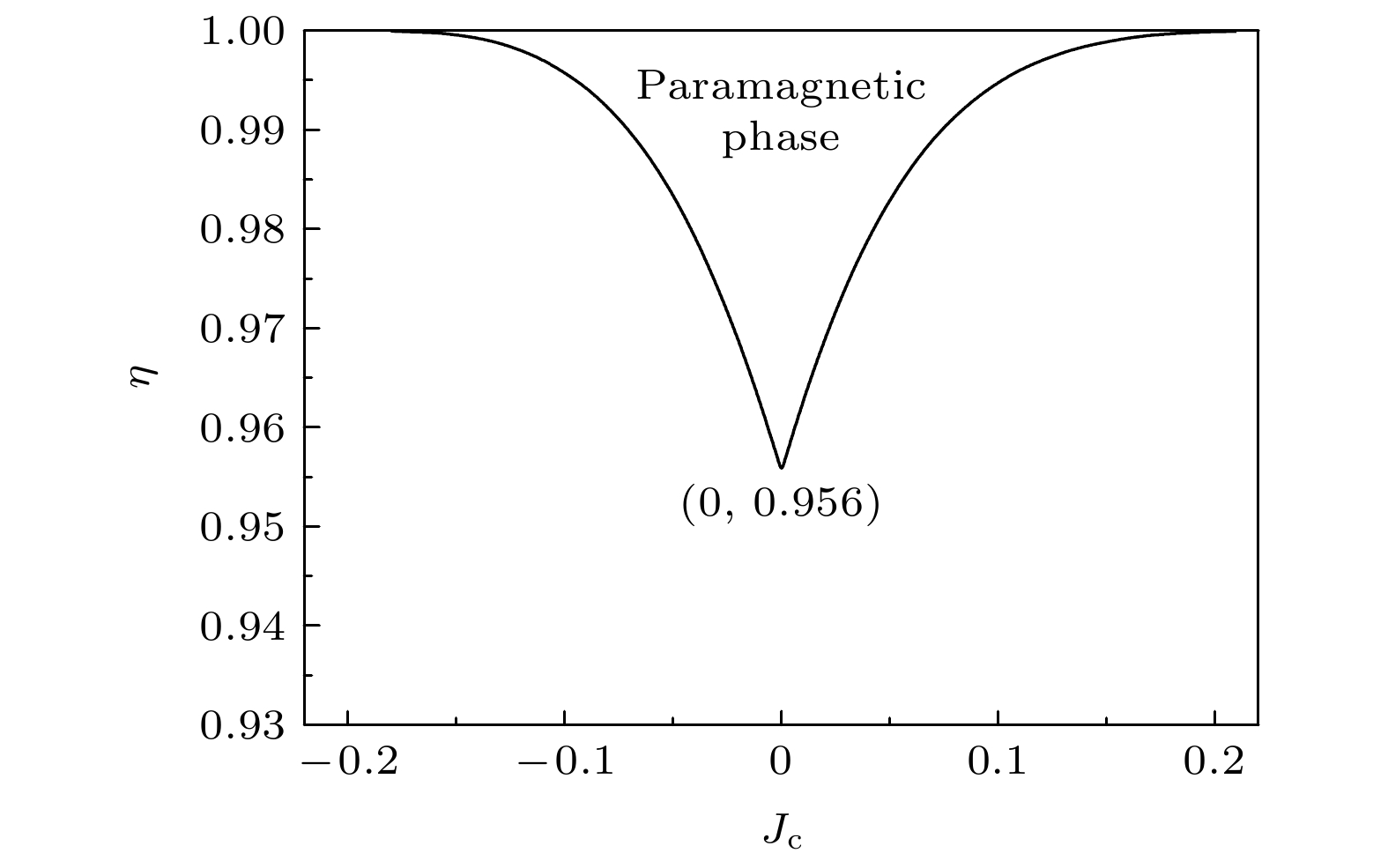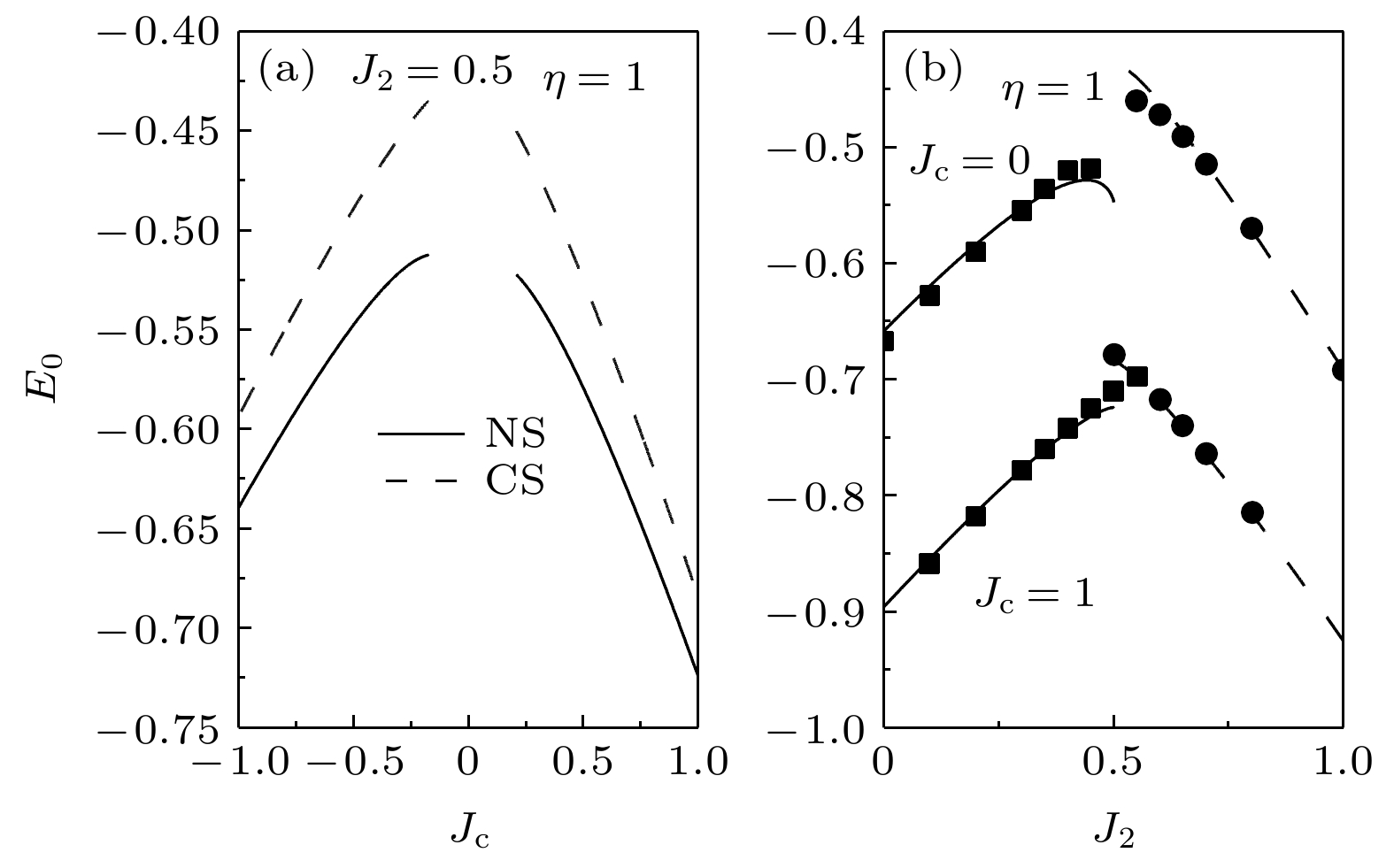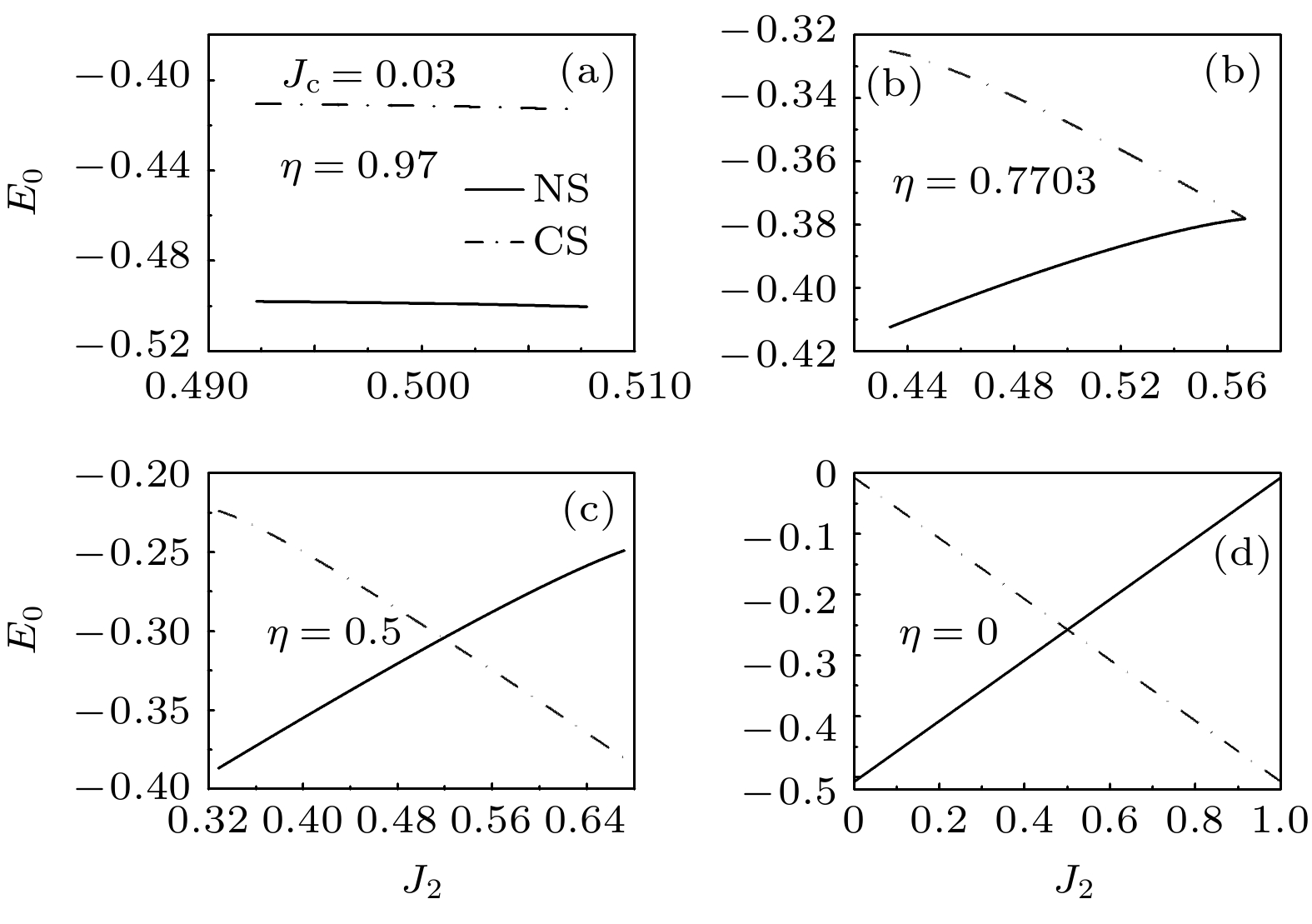-
基于线性自旋波理论, 研究了二维各向异性双层平方晶格阻挫模型的基态性质. 探讨了各向异性和自旋间交换作用对基态相图及系统可能发生相变的影响. 结果显示: 对于各向同性, 当层间耦合相互作用
$ {J_{\text{c}}} \geqslant $ $ 0.21 $ 或$ {J_{\text{c}}} \leqslant - 0.175 $ 时, Nèel态(NS)和Collinear态(CS)能共存; 对于各向异性, NS和CS也可以共存. 对弱的各向异性, NS更稳定; 对于强的各向异性, 系统将发生由NS向CS转换的一阶相变.-
关键词:
- 反铁磁 /
- 各向异性 /
- 磁序的一般理论和模型 /
- 交换和超交换相互作用
In this paper, we investigate the ground state phase transition of the spin-1/2 frustrated model on a stacked square lattice by the linear spin wave method. The effects of the anisotropy and the interplay of neighboring couplings on phase diagram and phase transformation between the Nèel state and collinear state are explored. Our results show that both the Nèel state and collinear state can exist due to the interplay of interlayer coupling$ {J_{\text{c}}} \geqslant 0.21 $ or$ {J_{\text{c}}} \leqslant - 0.175 $ for an isotropic system. For an anisotropic system, both the Nèel state and collinear state may also exist. In this case, for the weak anisotropy, the Nèel state is more stable. For the strong anisotropy, the system will undergo a first-order phase transition from the Nèel state to the collinear state.-
Keywords:
- antiferromagnetic /
- magnetic anisotropy /
- general theory and models of magnetic ordering /
- exchange and superexchange interactions
[1] Chubukov A V, Jolicoeur T 1991 Phys. Rev. B 44 12050
 Google Scholar
Google Scholar
[2] Bishop R F, Farnell D J J, Parkinson J B 1998 Phys. Rev. B 58 6394
 Google Scholar
Google Scholar
[3] Metavitsiadis A, Sellmann D, Eggert S 2014 Phys. Rev. B 89 241104
 Google Scholar
Google Scholar
[4] Haghshenas R, Sheng D N 2018 Phys. Rev. B 97 174408
 Google Scholar
Google Scholar
[5] Sadrzadeh M, Haghshenas R, Langari A 2019 Phys. Rev. B 99 144414
 Google Scholar
Google Scholar
[6] Choo K, Neupert T, Carleo G 2019 Phys. Rev. B 100 125124
 Google Scholar
Google Scholar
[7] Doretto R L 2020 Phys. Rev. B 102 014415
 Google Scholar
Google Scholar
[8] Roscher D, Gneist N, Scherer M M, Trebst S, Diehl S 2019 Phys. Rev. B 100 125130
 Google Scholar
Google Scholar
[9] Bishop R F, Li P H Y, Darradi R, Schulenburg J, Richter J 2008 Phys. Rev. B 78 054412
 Google Scholar
Google Scholar
[10] Wang L, Sandvik A W 2018 Phys. Rev. Lett. 121 107202
 Google Scholar
Google Scholar
[11] Haghshenas R, Lan W W, Gong S S, Sheng D N 2018 Phys. Rev. B 97 184436
 Google Scholar
Google Scholar
[12] Sadrzadeh M, Haghshenas R, Jahromi S S, Langari A 2016 Phys. Rev. B 94 214419
 Google Scholar
Google Scholar
[13] Ferrari F, Becca F 2020 Phys. Rev. B 102 014417
 Google Scholar
Google Scholar
[14] Carretta P, Papinutto N, Azzoni C B, Mozzati M C, Pavarini E, Gonthier S, Millet P 2002 Phys. Rev. B 66 094420
 Google Scholar
Google Scholar
[15] Carretta P, Melzi R, Papinutto N, Millet P 2002 Phys. Rev. Lett. 88 047601
 Google Scholar
Google Scholar
[16] Nath R, Tsirlin A A, Rosner H, Geibel C 2008 Phys. Rev. B 78 064422
 Google Scholar
Google Scholar
[17] Zhao J, Yao D X, Li S, Hong T, Chen Y, Chang S, Ratcliff W, Lynn J W, Mook H A, Chen G F, Luo J L, Wang N L, Carlson E W, Hu J, Dai P 2008 Phys. Rev. Lett. 101 167203
 Google Scholar
Google Scholar
[18] Ewings R A, Perring T G, Bewley R I, Guidi T, Pitcher M J, Parker D R, Clarke S J, Boothroyd A T 2008 Phys. Rev. B 78 220501
 Google Scholar
Google Scholar
[19] Johnston D C, McQueeney R J, Lake B, Honecker A, Zhitomirsky M E, Nath R, Furukawa Y, Antropov V P, Singh Y 2011 Phys. Rev. B 84 094445
 Google Scholar
Google Scholar
[20] Holt M, Sushkov O P, Stanek D, Uhrig G S 2011 Phys. Rev. B 83 144528
 Google Scholar
Google Scholar
[21] Fan Z, Jie Q L 2014 Phys. Rev. B 89 054418
 Google Scholar
Google Scholar
[22] Schmalfuß D, Darradi R, Richter J, Schulenburg J, Ihle D 2006 Phys. Rev. Lett. 97 157201
 Google Scholar
Google Scholar
[23] Nunes W A, Ricardo de Sousa J, Roberto Viana J, Richter J 2010 J. Phys.: Condens. Matter. 22 146004
 Google Scholar
Google Scholar
[24] Majumdar K 2011 J. Phys.: Condens. Matter 23 046001
 Google Scholar
Google Scholar
[25] Thalmeier P, Zhitomirsky M E, Schmidt B, Shannon N 2008 Phys. Rev. B 77 104441
 Google Scholar
Google Scholar
[26] Rojas O, Hamer C J, Oitmaa J 2011 J. Phys.: Condens. Matter. 23 416001
 Google Scholar
Google Scholar
[27] Isaev L, Ortiz G 2012 Phys. Rev. B 86 100402
 Google Scholar
Google Scholar
[28] Bishop R F, Li P H Y, Götze O, Richter J 2019 Phys. Rev. B 100 024401
 Google Scholar
Google Scholar
[29] Holstein T, Primakoff H 1940 Phys. Rev. 58 1098
 Google Scholar
Google Scholar
[30] Dyson F J 1956 Phys. Rev. 102 1217
 Google Scholar
Google Scholar
[31] Oitmaa J, Zheng W H 1996 Phys. Rev. B 54 3022
 Google Scholar
Google Scholar
[32] Majumdar K 2010 Phys. Rev. B 82 144407
 Google Scholar
Google Scholar
[33] Kalza A, Honecker A, Fuchs S, Pruschke T 2008 Eur. Phys. J. B 65 533
 Google Scholar
Google Scholar
[34] Jin S, Sen A, Sandvik A W 2012 Phys. Rev. Lett. 108 045702
 Google Scholar
Google Scholar
-
图 1 NS和CS的磁构型 (a), (b) 层间耦合为反铁磁相互作用; (c), (d)层间耦合为铁磁相互作用. 实心和空心圆圈分别描述的是自旋取向相上和向下
Fig. 1. Spin configurations of the NS and CS: (a), (b) Interlayer coupling as antiferromagnetic interactions; (c), (d) interlayer coupling as ferromagnetic interactions. The solid and empty circles represent the up-spins and down-spins, respectively.
图 2 当
$ \eta = 1 $ 时, 不同$ {J_{\text{c}}} $ 下的子晶格磁化强度$ m $ 与$ {J_2} $ 之间的关系 (a)$ {J_{\text{c}}} = 0, 0.21, 1 $ ; (b)$ {J_{\text{c}}} = 0, - 0.175, - 1 $ ; (c)$ {J_{\text{c}}} = 0 $ ; (d)$ {J_{\text{c}}} = 1 $ . 图(c)和(d)中, 短划线、空心方格、实心圆、实心三角形和破折号分别描述的是线性自旋波理论(本文的结果, LSW)、系列展开法到9阶(SE I)[31]、系列展开法到12阶(SE II)[26]、耦合团簇方法(CCM)[31]和二阶自旋波理论(SOSW)[32]的结果Fig. 2. Sublattice magnetization
$ m $ as a function of$ {J_2} $ for different$ {J_{\text{c}}} $ values at$ \eta = 1 $ : (a)$ {J_{\text{c}}} = 0, 0.21, 1 $ ; (b)$ {J_{\text{c}}} = $ $ 0, - 0.175, - 1 $ ; (c)$ {J_{\text{c}}} = 0 $ ; (d)$ {J_{\text{c}}} = 1 $ . In panel (c) and (d), the shorted-dashed lines, open squares, filled circles, filled triangles and dashed-doted lines represent the results of the linear spin wave (this paper, LSW), the series expansion up to the 9th order (SE I)[31], the series expansion up to the 12th order (SE II) [26], the couple-cluster method (CCM)[31] and second-order spin wave (SOSW)[32], respectively.图 4 不同参数时的磁化强度
$ m $ 与$ {J_2} $ 的关系 (a)$ {J_{\text{c}}} = 0, \eta = 0.956 $ ; (b)${J_{\rm c}} = 0.025, \eta = 0.9718$ ; (c)$ {J_{\text{c}}} = - 0.058, \eta = 0.987 $ ; (d)$ {J_{\text{c}}} = 0.3, \eta = 0.8 $ ; (e)$ {J_{\text{c}}} = 0.3, \eta = 0.8 $ ; (f)$ {J_{\text{c}}} = - 0.3, \eta = 0, 0.8, 0.9, 1 $ Fig. 4. Sublattice magnetization
$ m $ as a function of$ {J_2} $ for different parameter values: (a)$ {J_{\text{c}}} = 0, \eta = 0.956 $ ; (b)${J_{\rm c}} = 0.025, $ $ \eta = 0.9718$ ; (c)$ {J_{\text{c}}} = - 0.058, \eta = 0.987 $ ; (d)$ {J_{\text{c}}} = 0.3, \eta = 0.8 $ ; (e)$ {J_{\text{c}}} = 0.3, \eta = 0.8 $ ; (f)$ {J_{\text{c}}} = - 0.3, \eta = 0, 0.8, 0.9, 1 $ .图 5 在参数
$ \eta $ -$ {J_{\text{c}}} $ 空间中两个态共存所对应的区域. 平面分成了两个区域: 顺磁相和两个态共存的区域. 在共存区域$ {J_2} $ 的取值范围是$ J_2^1 \leqslant {J_2} \leqslant J_2^2 $ . 相应的例子是图4(e)Fig. 5. Area corresponding to the coexistence of the two states in the
$\eta \text{-} {J_{\text{c}}}$ space. The plane is divided into the two areas: paramagnetic phase and the coexistence of the two states. In the coexistence area of the two states , the value range of$ {J_2} $ is$ J_2^1 \leqslant {J_2} \leqslant J_2^2 $ . The corresponding example is Fig. 4(e).图 6 (a)当
$ {J_2} = 0.5 $ 时, NS和CS的基态能$ {E_0} $ 与$ {J_{\text{c}}} $ 的关系; (b)当$ {J_{\text{c}}} = 0, 1 $ 时, NS和CS的基态能$ {E_0} $ 与$ {J_2} $ 的关系. 实心方块和实心圆是系列展开法(SE II)的结果[26]Fig. 6. (a) Ground state energy
$ {E_0} $ of the Néel and collinear states as a function of$ {J_{\text{c}}} $ for$ {J_2} = 0.5 $ ; (b) ground state energy$ {E_0} $ of the Néel and collinear states as a function of$ {J_2} $ for$ {J_{\text{c}}} = 0, 1 $ . The filled squares and filled circles are the results of the series expansion up to the 12th order (SE II)[26].图 7 当
$ {J_{\text{c}}} = 0.03 $ 时, 不同$ \eta $ 值下两个态的基态能$ {E_0} $ 与$ {J_2} $ 的关系 (a)$ \eta = 0.97 $ ; (b)$ \eta = 0.7703 $ ; (c)$ \eta = 0.5 $ ; (d)$\eta = 0$ Fig. 7. Ground state energy
$ {E_0} $ of the two states as a function of$ {J_2} $ for different$ \eta $ values when$ {J_{\text{c}}} = 0.03 $ : (a)$\eta = $ $ 0.97$ ; (b)$ \eta = 0.7703 $ ; (c)$ \eta = 0.5 $ ; (d)$ \eta = 0 $ . -
[1] Chubukov A V, Jolicoeur T 1991 Phys. Rev. B 44 12050
 Google Scholar
Google Scholar
[2] Bishop R F, Farnell D J J, Parkinson J B 1998 Phys. Rev. B 58 6394
 Google Scholar
Google Scholar
[3] Metavitsiadis A, Sellmann D, Eggert S 2014 Phys. Rev. B 89 241104
 Google Scholar
Google Scholar
[4] Haghshenas R, Sheng D N 2018 Phys. Rev. B 97 174408
 Google Scholar
Google Scholar
[5] Sadrzadeh M, Haghshenas R, Langari A 2019 Phys. Rev. B 99 144414
 Google Scholar
Google Scholar
[6] Choo K, Neupert T, Carleo G 2019 Phys. Rev. B 100 125124
 Google Scholar
Google Scholar
[7] Doretto R L 2020 Phys. Rev. B 102 014415
 Google Scholar
Google Scholar
[8] Roscher D, Gneist N, Scherer M M, Trebst S, Diehl S 2019 Phys. Rev. B 100 125130
 Google Scholar
Google Scholar
[9] Bishop R F, Li P H Y, Darradi R, Schulenburg J, Richter J 2008 Phys. Rev. B 78 054412
 Google Scholar
Google Scholar
[10] Wang L, Sandvik A W 2018 Phys. Rev. Lett. 121 107202
 Google Scholar
Google Scholar
[11] Haghshenas R, Lan W W, Gong S S, Sheng D N 2018 Phys. Rev. B 97 184436
 Google Scholar
Google Scholar
[12] Sadrzadeh M, Haghshenas R, Jahromi S S, Langari A 2016 Phys. Rev. B 94 214419
 Google Scholar
Google Scholar
[13] Ferrari F, Becca F 2020 Phys. Rev. B 102 014417
 Google Scholar
Google Scholar
[14] Carretta P, Papinutto N, Azzoni C B, Mozzati M C, Pavarini E, Gonthier S, Millet P 2002 Phys. Rev. B 66 094420
 Google Scholar
Google Scholar
[15] Carretta P, Melzi R, Papinutto N, Millet P 2002 Phys. Rev. Lett. 88 047601
 Google Scholar
Google Scholar
[16] Nath R, Tsirlin A A, Rosner H, Geibel C 2008 Phys. Rev. B 78 064422
 Google Scholar
Google Scholar
[17] Zhao J, Yao D X, Li S, Hong T, Chen Y, Chang S, Ratcliff W, Lynn J W, Mook H A, Chen G F, Luo J L, Wang N L, Carlson E W, Hu J, Dai P 2008 Phys. Rev. Lett. 101 167203
 Google Scholar
Google Scholar
[18] Ewings R A, Perring T G, Bewley R I, Guidi T, Pitcher M J, Parker D R, Clarke S J, Boothroyd A T 2008 Phys. Rev. B 78 220501
 Google Scholar
Google Scholar
[19] Johnston D C, McQueeney R J, Lake B, Honecker A, Zhitomirsky M E, Nath R, Furukawa Y, Antropov V P, Singh Y 2011 Phys. Rev. B 84 094445
 Google Scholar
Google Scholar
[20] Holt M, Sushkov O P, Stanek D, Uhrig G S 2011 Phys. Rev. B 83 144528
 Google Scholar
Google Scholar
[21] Fan Z, Jie Q L 2014 Phys. Rev. B 89 054418
 Google Scholar
Google Scholar
[22] Schmalfuß D, Darradi R, Richter J, Schulenburg J, Ihle D 2006 Phys. Rev. Lett. 97 157201
 Google Scholar
Google Scholar
[23] Nunes W A, Ricardo de Sousa J, Roberto Viana J, Richter J 2010 J. Phys.: Condens. Matter. 22 146004
 Google Scholar
Google Scholar
[24] Majumdar K 2011 J. Phys.: Condens. Matter 23 046001
 Google Scholar
Google Scholar
[25] Thalmeier P, Zhitomirsky M E, Schmidt B, Shannon N 2008 Phys. Rev. B 77 104441
 Google Scholar
Google Scholar
[26] Rojas O, Hamer C J, Oitmaa J 2011 J. Phys.: Condens. Matter. 23 416001
 Google Scholar
Google Scholar
[27] Isaev L, Ortiz G 2012 Phys. Rev. B 86 100402
 Google Scholar
Google Scholar
[28] Bishop R F, Li P H Y, Götze O, Richter J 2019 Phys. Rev. B 100 024401
 Google Scholar
Google Scholar
[29] Holstein T, Primakoff H 1940 Phys. Rev. 58 1098
 Google Scholar
Google Scholar
[30] Dyson F J 1956 Phys. Rev. 102 1217
 Google Scholar
Google Scholar
[31] Oitmaa J, Zheng W H 1996 Phys. Rev. B 54 3022
 Google Scholar
Google Scholar
[32] Majumdar K 2010 Phys. Rev. B 82 144407
 Google Scholar
Google Scholar
[33] Kalza A, Honecker A, Fuchs S, Pruschke T 2008 Eur. Phys. J. B 65 533
 Google Scholar
Google Scholar
[34] Jin S, Sen A, Sandvik A W 2012 Phys. Rev. Lett. 108 045702
 Google Scholar
Google Scholar
计量
- 文章访问数: 2767
- PDF下载量: 63
- 被引次数: 0


















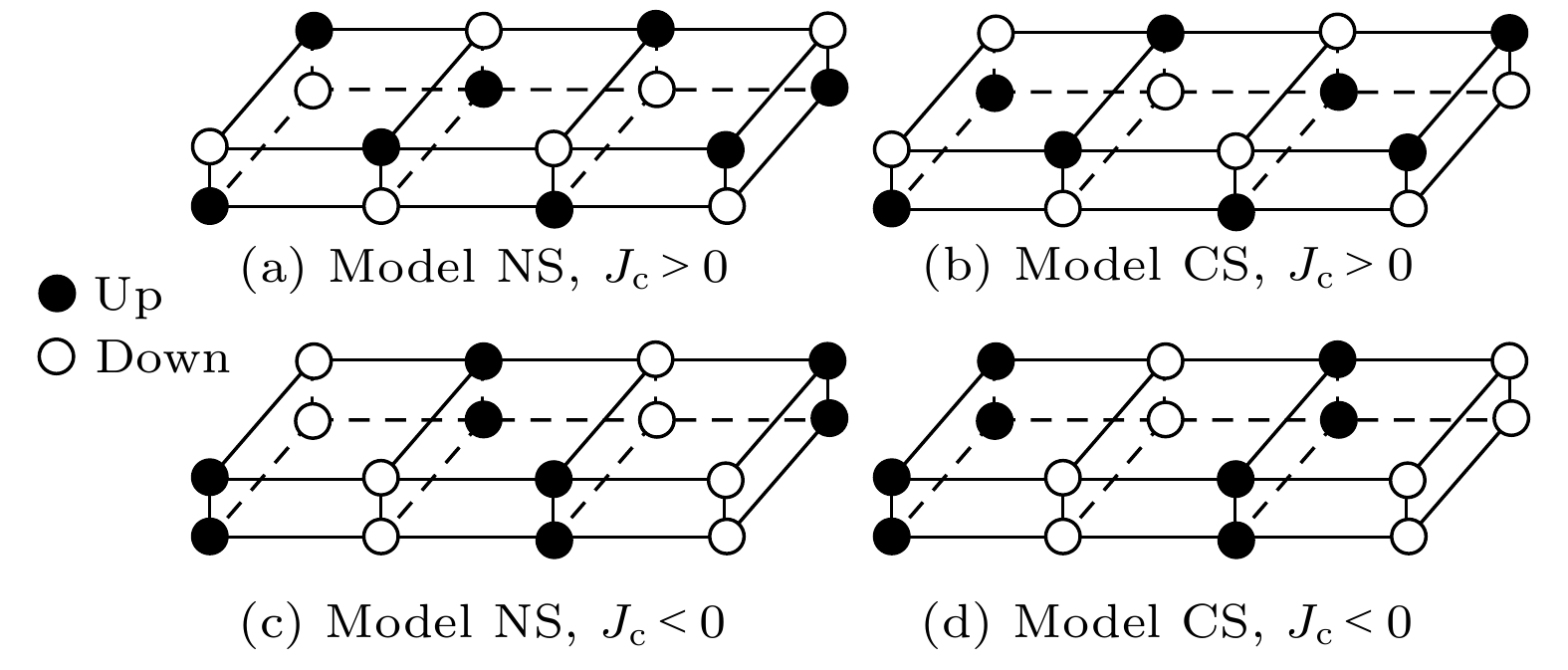
 下载:
下载:
